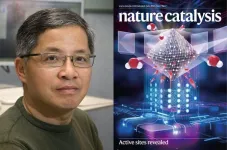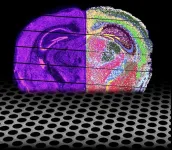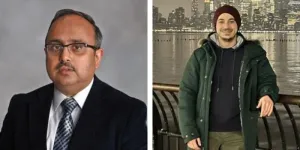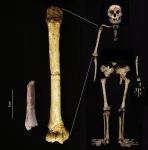(Press-News.org) The chemical and energy industries depend upon catalysts to drive the reactions used to create their products. Many important reactions use heterogeneous catalysts — meaning that the catalysts are in a different phase of matter than the substances they are reacting with, such as solid platinum reacting with gases in an automobile’s catalytic converter.
Scientists have investigated the surface of well-defined single crystals, illuminating the mechanisms underlying many chemical reactions. However, there is much more to be learned. For heterogeneous catalysts, their 3D atomic structure, their chemical composition and the nature of their active sites, where reactions take place, have long remained elusive.
Now, research led by members of the California NanoSystems Institute at UCLA has determined the 3D atomic coordinates, chemical makeup and surface composition of heterogenous nanocatalysts — sized on the scale of billionths of a meter — used in chemical reactions driven by electricity.
The team’s technique could profoundly impact the fundamental understanding of catalysts’ active sites and enable engineers to rationally design nanocatalysts in a way that optimizes their performance, whereas current methods are closer to trial and error.
The study, which appeared on the cover of the July issue of Nature Catalysis, was led by corresponding authors and CNSI members Jianwei “John” Miao, a professor of physics and astronomy at the UCLA College; Yu Huang, the Traugott and Dorothea Frederking Endowed Professor and the chair of the materials science and engineering department at the UCLA Samueli School of Engineering; and Philippe Sautet, a distinguished professor of chemical and biomolecular engineering and the vice chair for graduate education at UCLA Samueli.
Using advances they developed for a microscopy technique called atomic electron tomography, the team studied 11 nanoparticles consisting of either a platinum-nickel alloy alone or that alloy plus traces of molybdenum, another metal that can serve as a catalyst. The researchers were able to measure a host of characteristics at atomic resolution, including the nanoparticles’ facets, their surface indentations, and the relative orderliness of the catalysts’ structures and chemical components.
The data from atomic electron tomography were plugged into artificial intelligence models trained based on fundamental principles of physics and chemistry. With the algorithms, the investigators identified the active sites where catalysis takes place. Those findings were then validated with real-world measurements.
The scientists’ observations revealed that chemical activity at the surface platinum sites varies widely — by several orders of magnitude. The team conducted a comprehensive analysis of the relationship between the nanocatalysts’ structure and chemical activity at the level of individual atoms to formulate an equation providing quantitative insights into the nanocatalysts’ active sites.
Although this study focused on platinum-based alloy nanocatalysts in a specific electrochemical reaction, the general method can be applied with a wide range of nanocatalysts for various reactions to determine the local 3D positions of atoms, as well as the catalysts’ elemental makeup and surface composition.
The study’s co-first authors are Yao Yang of Westlake University in China and UCLA’s Jihan Zhou, Zipeng Zhao and Geng Sun. Other co-authors are Saman Moniri, Yongsoo Yang, Ziyang Wei, Yakun Yuan and Yang Liu, all of UCLA; Colin Ophus, Jim Ciston and Peter Ercius of Lawrence Berkeley National Laboratory’s Molecular Foundry; Cheng Zhu and Hendrik Heinz of the University of Colorado at Boulder; and Qiang Sun and Qingying Jia of Northeastern University.
END
Researchers reveal atomic-scale details of catalysts’ active sites
New technique from the CNSI at UCLA may lead to design approaches that optimize the performance of chemical reactions
2024-08-06
ELSE PRESS RELEASES FROM THIS DATE:
The prescription for a healthier democracy
2024-08-06
When we’re sick, the first step on the road to recovery is a visit to the doctor’s office.
It turns out the same may also be true for breathing life into America’s democracy.
A Rutgers University–New Brunswick study published in the journal JAMA Health Forum finds that physicians can play a crucial role in strengthening political inclusion of marginalized groups by aiding patients in voter registration.
“Hospitals aren’t the first place we think of when it comes to voter registration,” said Katherine McCabe, an associate professor of American politics at Rutgers University-New Brunswick and lead ...
New substrate material for flexible electronics could help combat e-waste
2024-08-06
Electronic waste, or e-waste, is a rapidly growing global problem, and it’s expected to worsen with the production of new kinds of flexible electronics for robotics, wearable devices, health monitors, and other new applications, including single-use devices.
A new kind of flexible substrate material developed at MIT, the University of Utah, and Meta has the potential to enable not only the recycling of materials and components at the end of a device’s useful life, but also the scalable manufacture of more ...
Johns Hopkins Medicine scientists probe molecular cause of COVID-19 related diarrhea, revealing potential treatments
2024-08-06
Working with human stem cells that form a kind of “mini intestine-in-a-dish,” Johns Hopkins Medicine scientists say they have found several molecular mechanisms for COVID-19-related diarrhea, suggesting potential ways to control it.
Details of the experiments in a model of human intestinal tissue, called enteroids, are described on July 30 in Cellular and Molecular Gastroenterology and Hepatology.
Along with the unpleasant aches, fever, sore throat, cough, respiratory distress and other symptoms that may accompany COVID-19 infection, up to half of people who get the virus will experience diarrhea. Some 30% of them will go on to develop ...
New open-source platform for high-resolution spatial transcriptomics
2024-08-06
Leuven, 6 August 2024 - A team of researchers from the lab of Prof. Stein Aerts (VIB-KU Leuven) presents Nova-ST, a new spatial transcriptomics technique that promises to transform gene expression profiling in tissue samples. Nova-ST will make large-scale, high-resolution spatial tissue analysis more accessible and affordable, offering significant benefits for researchers. The research was published in Cell Reports Methods.
Transcriptomics is the study of gene expression in a cell or a population of cells, but it usually does not include spatial information about where those genes were active. This hurdle limited our understanding of complex ...
Targeted cancer therapy: initial high concentration may slow down selection for resistance
2024-08-06
BUFFALO, NY- August 6, 2024 – On July 28, 2024, Mikhail V. Blagosklonny M.D., Ph.D., from Roswell Park Comprehensive Cancer Center published a new editorial in Volume 16, Issue 14 of Aging (listed by MEDLINE/PubMed as "Aging (Albany NY)" and "Aging-US" by Web of Science), entitled, “Targeted cancer therapy: the initial high concentration may slow down the selection for resistance.”
“Unfortunately, any targeted therapy is, always, started with low levels of the drug in the organism, selecting for drug resistance. One should propose that initial drug levels must be maximized, ...
Lehigh University researchers dig deeper into stability challenges of nuclear fusion—with mayonnaise
2024-08-06
Mayonnaise continues to help researchers better understand the physics behind nuclear fusion.
“We’re still working on the same problem, which is the structural integrity of fusion capsules used in inertial confinement fusion, and Hellmann’s Real Mayonnaise is still helping us in the search for solutions,” says Arindam Banerjee, the Paul B. Reinhold Professor of Mechanical Engineering and Mechanics at Lehigh University and Chair of the MEM department in the P.C. Rossin College of Engineering and Applied Science.
In simple terms, fusion reactions are what power the sun. If the process could ...
Texas Tech professor receives grant for printable semiconductors research
2024-08-06
Minxiang “Glenn” Zeng, an assistant professor in the Department of Chemical Engineering at Texas Tech University, has been awarded a $250,000 grant from the Launching Early-Career Academic Pathways in the Mathematical and Physical Sciences (LEAPS-MPS) award from the National Science Foundation (NSF) to further his research about printable semiconductors and electronics under extreme environments.
The grant supports Zeng’s work in understanding and controlling the thermal degradation pathways of printed metal chalcogenides, which are semiconductor materials including selenides, tellurides and sulfides. His goal is to develop strategies to enhance the thermal stability ...
Digital Olfaction Society 2024: Revolutionizing scent digitization and global transfer
2024-08-06
The 8th Annual Meeting of the Digital Olfaction Society (DOS) will take place on December 5-6, 2024, in Tokyo, Japan, and Online. The DOS meeting is uniquely aimed at digitizing scents, transferring them, and re-creating them in different parts of the world. The two-day event includes one day dedicated to talks and another day for demonstrations. Under the slogan "Olfaction to Digital Olfaction", the congress will explore the latest advances in olfaction science and digital olfaction technologies, highlighting their transformative impact across multiple fields.
The first day of the congress will focus on olfaction science, scent-based diagnosis and treatment ...
New York City’s fireworks display prompts temporary surge of air pollution
2024-08-06
In 2023, roughly 60,000 firework shells exploded above Manhattan’s East River as part of Macy’s Fourth of July show. The resulting air pollutant levels were many times higher in the hours after the display than those seen when smoke from a Canadian wildfire had blanketed the area a month before.
This is according to the results of a new study, led by researchers at NYU Langone Health, which measured air quality just before and after the Independence Day event, one of the largest in the United States. Tiny particles of hazardous metals and organic compounds peaked at 3,000 micrograms per cubic meter at an air sampling site ...
Smallest arm bone in human fossil record sheds light on the dawn of Homo floresiensis
2024-08-06
A paper out today in Nature Communications reports the discovery of extremely rare early human fossils from the Indonesian island of Flores, including an astonishingly small adult limb bone.
Dated to about 700,000 years old, the new findings shed light on the evolution of Homo floresiensis, the so-called ‘Hobbits’ of Flores whose remains were uncovered in 2003 at Liang Bua cave in the island’s west by a team co-led by Australian-New Zealand archaeologist Professor Mike Morwood (1950–2013).
Archaeological evidence suggests these diminutive, small-brained humans inhabited Liang Bua ...
LAST 30 PRESS RELEASES:
Numbers in our sights affect how we perceive space
SIMJ announces global collaborative book project in commemoration of its 75th anniversary
Air pollution exposure and birth weight
Obstructive sleep apnea risk and mental health conditions among older adults
How talking slows eye movements behind the wheel
The Ceramic Society of Japan’s Oxoate Ceramics Research Association launches new international book project
Heart-brain connection: international study reveals the role of the vagus nerve in keeping the heart young
Researchers identify Rb1 as a predictive biomarker for a new therapeutic strategy in some breast cancers
Survey reveals ethical gaps slowing AI adoption in pediatric surgery
Stimulant ADHD medications work differently than thought
AI overestimates how smart people are, according to HSE economists
HSE researchers create genome-wide map of quadruplexes
Scientists boost cell "powerhouses" to burn more calories
Automatic label checking: The missing step in making reliable medical AI
Low daily alcohol intake linked to 50% heightened mouth cancer risk in India
American Meteorological Society announces Rick Spinrad as 2026 President-Elect
Biomass-based carbon capture spotlighted in newly released global climate webinar recording
Illuminating invisible nano pollutants: advanced bioimaging tracks the full journey of emerging nanoscale contaminants in living systems
How does age affect recovery from spinal cord injury?
Novel AI tool offers prognosis for patients with head and neck cancer
Fathers’ microplastic exposure tied to their children’s metabolic problems
Research validates laboratory model for studying high-grade serous ovarian cancer
SIR 2026 delivers transformative breakthroughs in minimally invasive medicine to improve patient care
Stem Cell Reports most downloaded papers of 2025 highlight the breadth and impact of stem cell research
Oxford-led study estimates NHS spends around 3% of its primary and secondary care budget on the health impacts of heat and cold in England
A researcher’s long quest leads to a smart composite breakthrough
Urban wild bees act as “microbial sensors” of city health.
New study finds where you live affects recovery after a hip fracture
Forecasting the impact of fully automated vehicle adoption on US road traffic injuries
Alcohol-related hospitalizations from 2016 to 2022
[Press-News.org] Researchers reveal atomic-scale details of catalysts’ active sitesNew technique from the CNSI at UCLA may lead to design approaches that optimize the performance of chemical reactions





